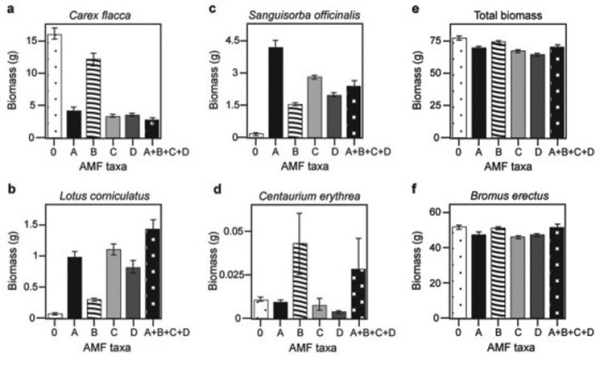Use the following information to answer the question.
Canadian and Swiss researchers wanted to know if the diversity of arbuscular mycorrhizal fungi (AMF) was important to the productivity of grasslands (M.G.A. van der Heijden, J. N. Klironomos, M. Ursic, P. Moutoglis, R. Streitwolf-Engel, T. Boler, A. Wiemken, and I. R. Sanders. 1998. Mycorrhizal fungal diversity determines plant biodiversity, ecosystem variability, and productivity. Nature 396:69-72) . Specifically, they wanted to know if it mattered which specific AMF species were present, or just that some type of AMF was present. They grew various plants in combination with one of four AMF species (A, B, C, and D) , no AMF species (O) , or all four AMF species together (A + B + C + D) ; and they measured plant growth under each set of conditions. All plant species were grown in each plot, so they always competed with each other with the only difference being which AMF species were present.
On the graphs, the x-axis labels indicate the number and identity of AMF species (bar 0 = no fungi; bars A - D = individual AMF species; bar A + B + C + D = all AMF species together) . The y-axis indicates the amount (grams) of plant biomass for the species shown in italics above each graph. Graph e is the total biomass (grams) of all 11 plant species combined; graph f is the biomass of Bromus erectus plants only, separated from the total.
Based on graphs e and f, which is the most well-supported prediction for the effect on total plant biomass if AMF diversity were increased to eight species?
Definitions:
Q1: The following question refers to the generalized
Q1: If you were able to walk into
Q12: Which of the following results would be
Q20: Within a gymnosperm megasporangium, which of the
Q25: Use the figure to answer the question.<br>A:
Q28: _ is a relatively indigestible strengthening polymer
Q60: Which of the following statements about bryozoans
Q60: A new species of aquatic chordate is
Q62: Which structure is correctly paired with its
Q74: The crown-of-thorns sea star, Acanthaster planci, preys